
The Best Energy-Efficient Doors: A Buyer's Roundup
Share
Why Energy-Efficient Doors Are Essential for Modern Homes
Energy efficient doors can prevent up to 25% of your home's energy loss while delivering lower utility bills, increased comfort, and improved curb appeal. Here's what makes a door energy-efficient:
Key Features to Look For:
- U-Factor of 0.17-0.40 (lower is better for insulation)
- Polyurethane foam core for superior insulation (R5-R7 values)
- Multi-pane glass with Low-E coatings
- Magnetic weatherstripping for tight seals
- ENERGY STAR certification for guaranteed performance
Top Materials by Efficiency:
- Fiberglass/Vinyl: R5-R7 (most efficient)
- Steel: R5-R6 (good security + efficiency)
- Wood: R2-R3 (least efficient but attractive)
Your front door isn't just an entrance - it's a critical component of your home's thermal envelope. According to government data, windows, doors, and skylights can account for up to 25% of energy loss in homes. The right energy-efficient door can reduce your heating and cooling costs by up to 13% while creating a more comfortable living environment year-round.
Modern energy-efficient doors combine advanced materials like polyurethane foam cores with sophisticated sealing systems and high-performance glass packages. Steel doors with foam insulation can offer more than five times the insulating value of solid wood doors, while European-style designs provide superior air sealing through innovative tilt-and-turn mechanisms and multi-point locking systems.
We've specialized in distributing premium European-engineered windows and doors that deliver exceptional thermal performance. My experience with energy efficient doors has shown me how the right products can transform both comfort and energy costs for homeowners.
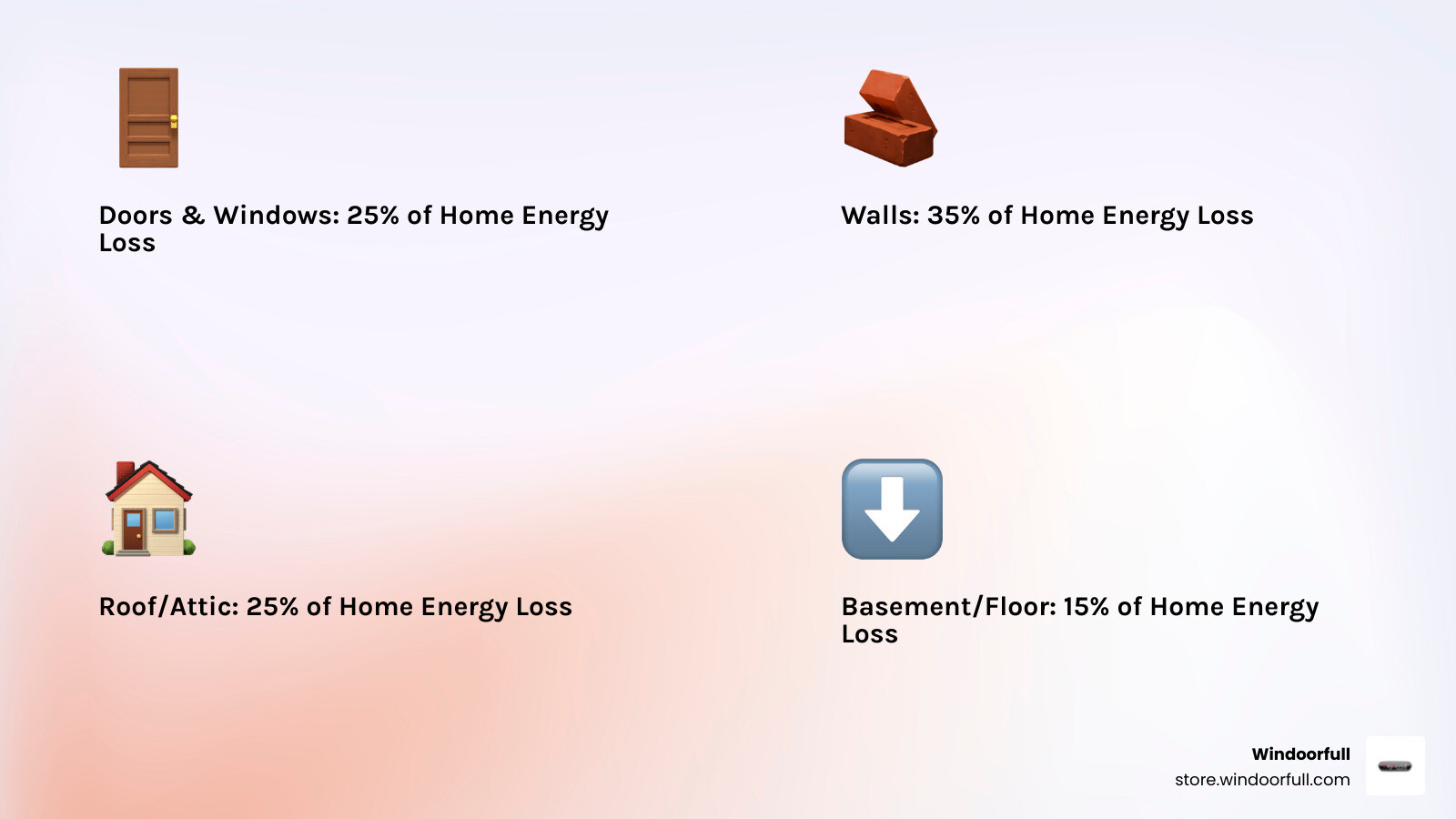
Decoding Energy Efficiency: What to Look For
Shopping for energy efficient doors can feel like learning a new language. But once you understand what makes a door truly energy-efficient, you'll be able to spot the real performers from the pretenders.
Think of an energy-efficient door as your home's thermal bodyguard. It's constantly working to keep the good stuff in (your heated or cooled air) and the bad stuff out (drafts, moisture, and extreme temperatures). This protection comes from four core components working together: superior insulation within the door itself, effective weatherstripping that seals every gap, high-performance frame materials that don't conduct heat, and advanced glass packages for doors with windows.
These components directly impact how well your door resists heat flow and prevents those sneaky drafts that make you wonder why your energy bills are so high. The magic happens when all these elements work in harmony.
Key Features of Energy-Efficient Doors
Let's break down the numbers that matter when you're evaluating door performance. Don't worry – I'll translate the technical jargon into plain English.
The U-Factor is your door's report card for insulation. It measures how much heat passes through the door, and lower numbers mean better performance. A quality steel or fiberglass door can offer more than five times the insulating value of solid wood. That's a game-changer for your comfort and energy bills.
For doors with glass, the Solar Heat Gain Coefficient (SHGC) tells you how much sun heat enters your home. In hot climates, you want a low SHGC to keep that blazing summer sun from turning your entryway into a greenhouse. In colder areas, a higher SHGC can actually help warm your home naturally.
R-Value is another way to measure thermal resistance – think of it as your door's winter coat thickness. Higher R-values mean better insulation. Fiberglass and vinyl doors typically boast impressive R5-R7 values, while steel doors deliver R5-R6, and traditional wood doors usually max out at R2-R3.
The air leakage rating measures how much unwanted air sneaks through your door assembly. ENERGY STAR looks for air leakage of 0.3 cubic feet per minute per square foot or less for sliding doors. That might sound technical, but it basically means virtually no drafts.
Many top-performing doors feature a polyurethane foam core – essentially a high-tech insulation blanket sandwiched inside the door. This material delivers exceptional R-values and keeps your indoor temperature steady.
For doors with glass inserts, multi-pane glass creates insulating air pockets that work like thermal barriers. These spaces are often filled with argon or krypton gas, which are denser than regular air and block heat transfer even better. Our blog has more info about triple glazing if you want to dive deeper into glass performance.
Low-E coatings are microscopic metallic layers applied to glass surfaces. They're like smart sunglasses for your door – reflecting heat back where it belongs while protecting your furniture from UV damage that causes fading.
Understanding ENERGY STAR and NFRC Labels
When you're investing in energy efficient doors, certifications take the guesswork out of your decision. Two labels deserve your attention: ENERGY STAR and NFRC.
The ENERGY STAR program is your government-backed guarantee of performance. This symbol means the door has been independently tested and certified to meet strict efficiency standards set by the EPA and Department of Energy. An ENERGY STAR certified door performs about 15% better than average doors – that's real money back in your pocket.
The NFRC label works like a nutrition label for your door's energy performance. The National Fenestration Rating Council provides objective, comparable data on U-factor, SHGC, and air leakage. You can find detailed NFRC label explained information to help decode these ratings.
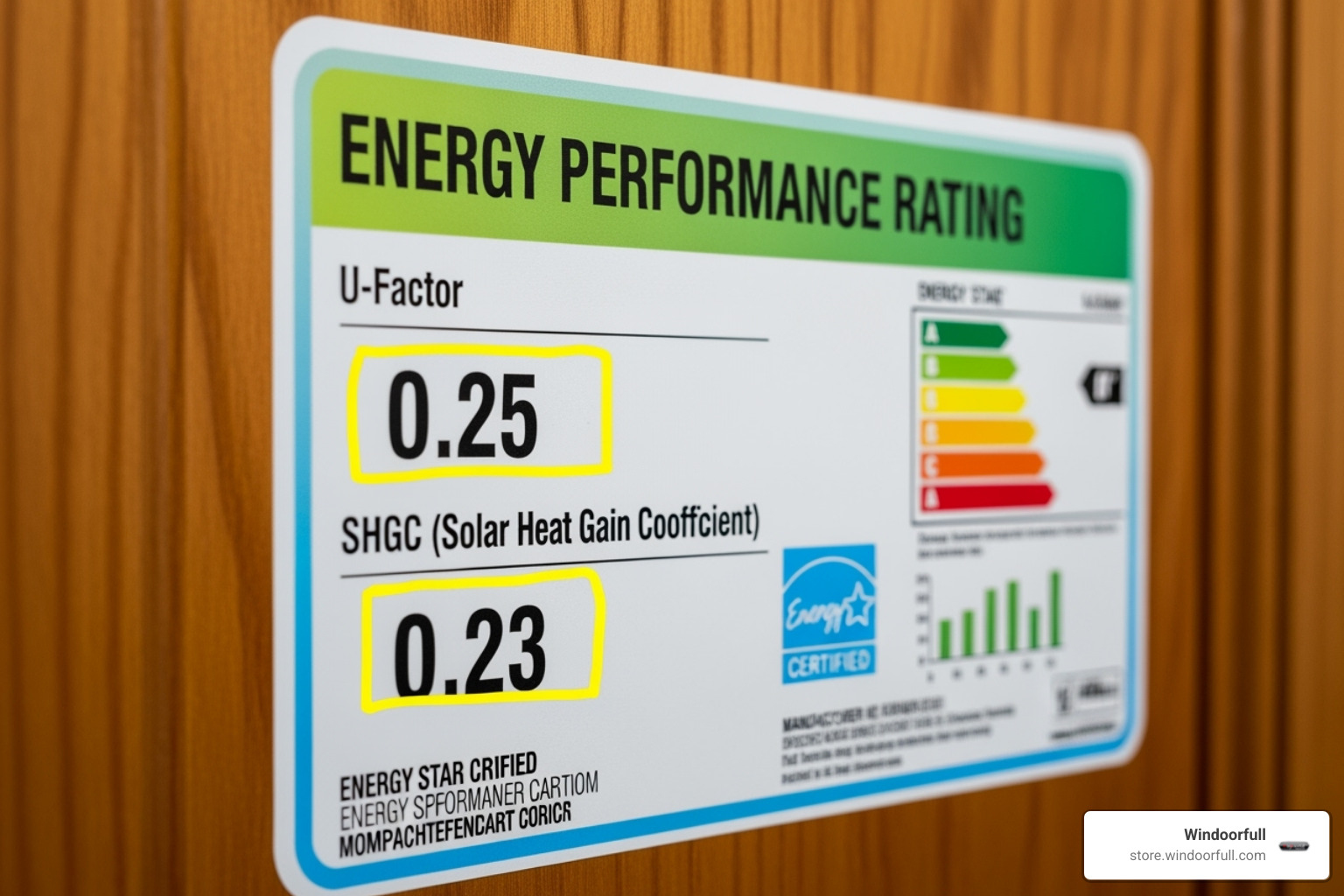
These certifications also account for climate zones – because what works perfectly in sunny Arizona might not be ideal for snowy Minnesota. ENERGY STAR tailors its requirements to specific regions across the country. The ENERGY STAR Climate Zone Finder helps you understand what performance standards apply to your area.
Choosing a door that meets or exceeds ENERGY STAR requirements for your climate zone ensures you're getting a product designed to perform in your specific weather conditions.
A Roundup of the Best Materials for Energy-Efficient Doors
When you're shopping for energy efficient doors, the material you choose makes all the difference. It's like picking the right jacket for winter – some materials just perform better when it comes to keeping the cold out and the warmth in. Let me walk you through the top contenders and help you understand what each brings to the table.
| Material | R-Value (Approx.) | Cost (Avg.) | Maintenance | Durability | Notes |
|---|---|---|---|---|---|
| Fiberglass | R5-R7 | Medium-High | Low | Excellent | Resists dents, rust, rot, warps. |
| Steel | R5-R6 | Low-Medium | Low | Very Good | Strong, secure, can dent. |
| uPVC/Vinyl | R5-R7 | Medium | Very Low | Excellent | Superior insulation, low conductivity. |
| Wood | R2-R3 | High | High | Good (with care) | Aesthetic, prone to warping/rotting. |
The numbers tell part of the story, but there's so much more to consider. Each material has its own personality, if you will, and understanding these differences will help you make the best choice for your home and budget.
Fiberglass Doors
If energy efficient doors had a poster child, fiberglass would be it. These doors are like the reliable friend who never lets you down – they perform beautifully year after year with minimal fuss.
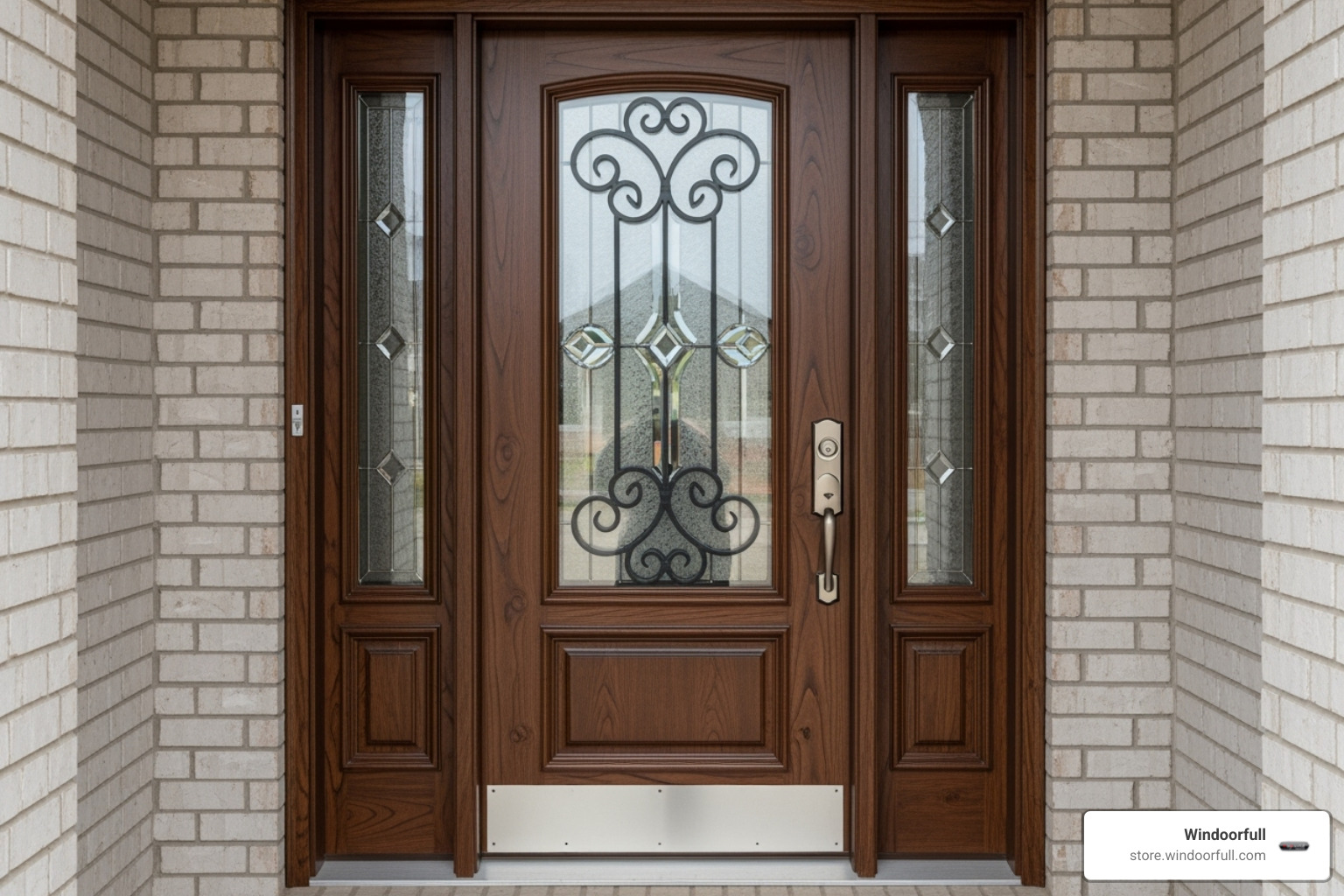
What makes fiberglass so special? It's all about that polyurethane foam core. This isn't your average insulation – it's like wrapping your home in a high-tech thermal blanket. With R-values ranging from R5 to R7, fiberglass doors offer some of the best insulation you can get.
The real beauty of fiberglass is its toughness. These doors laugh in the face of harsh weather. They won't dent, rust, or rot, and unlike their wooden cousins, they won't warp when humidity levels change. This means your door maintains that tight seal season after season, keeping your energy bills in check.
Here's a fun fact: modern fiberglass doors can look so much like real wood that even your neighbors might not know the difference. If you love the classic wood look but want modern performance, check out our guide on fiberglass faux wood doors benefits to see how you can have the best of both worlds.
Steel Doors
Steel doors are the workhorses of the door world. They're affordable, secure, and surprisingly energy-efficient, typically offering R-values between R5 and R6.
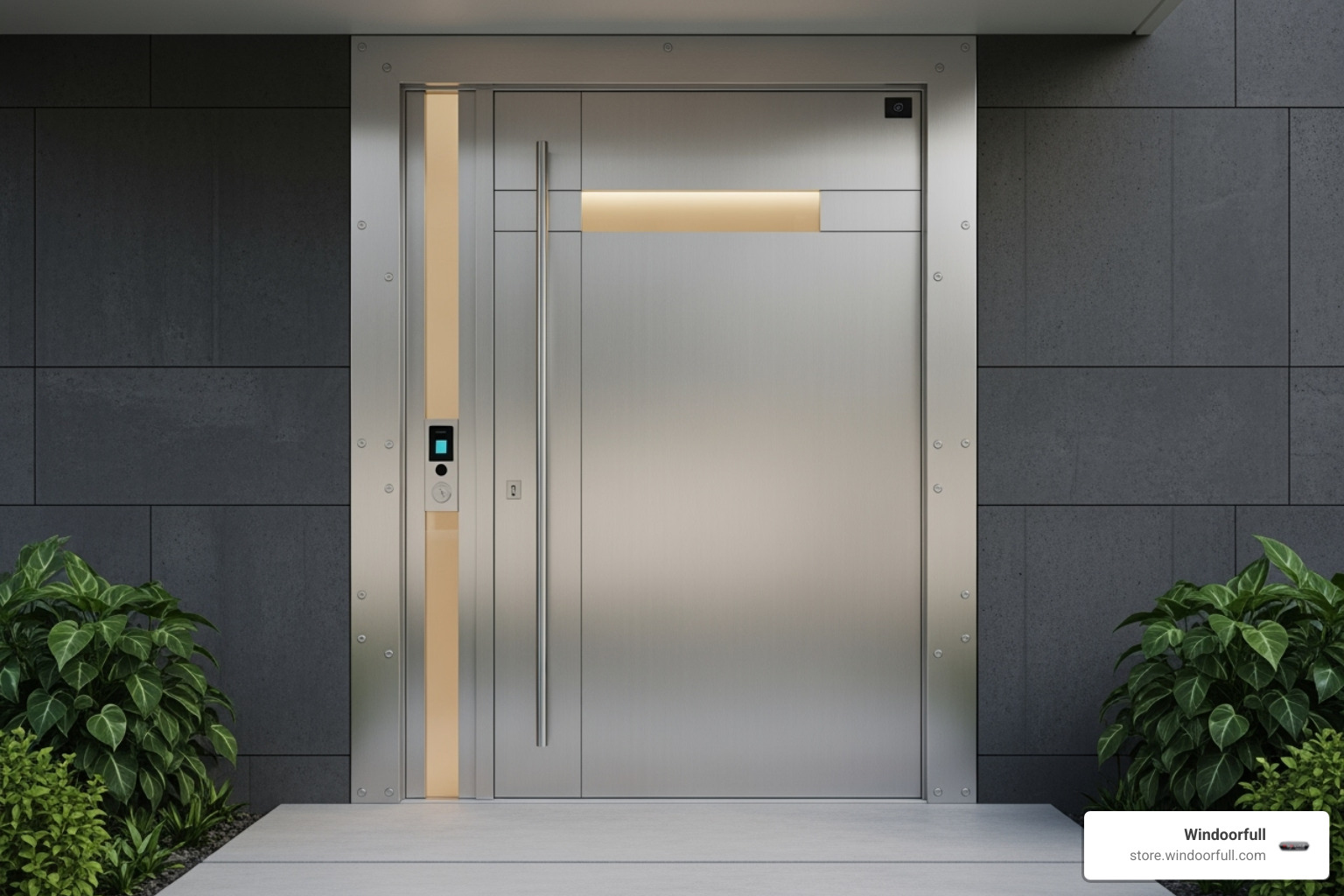
Like fiberglass doors, steel doors get their insulating power from foam core insulation, usually polyurethane. But here's what makes them unique: they often use magnetic weatherstripping – yes, just like your refrigerator door! This creates an incredibly tight seal that keeps air from sneaking through.
From a security standpoint, steel doors are hard to beat. They're built like fortresses and can withstand serious attempts at forced entry. The trade-off? They can dent if something heavy hits them. But for most homeowners, the combination of security, affordability, and solid energy performance makes steel an excellent choice.
uPVC/Vinyl and European-Style Doors
Now we're getting to my favorite topic – the doors that truly represent the cutting edge of energy efficiency. European-engineered uPVC doors don't just meet energy standards; they set them.
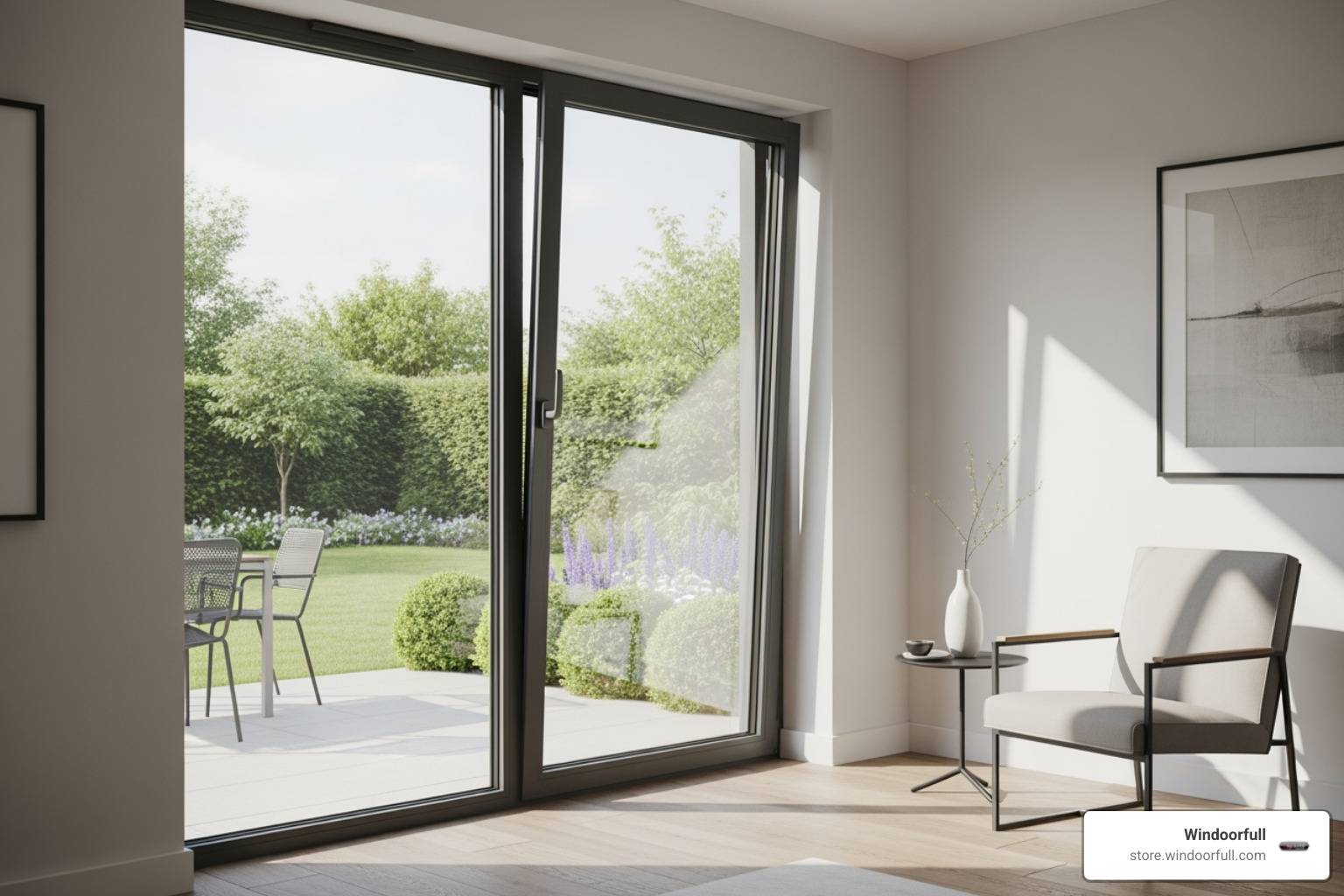
What makes these doors so special? It starts with their multi-chambered profiles. Think of them as having multiple insulating air pockets built right into the frame. Combined with advanced glazing options – often double or triple-pane with Low-E coatings – these doors achieve superior insulation that's hard to match.
The tilt and turn functionality isn't just about convenience (though being able to tilt your door for ventilation while keeping it locked is pretty amazing). It's about precision engineering. These doors feature multi-point locking systems that engage at several points around the frame, creating a seal so tight it's almost vacuum-like.
uPVC itself is naturally resistant to temperature changes, which means the door won't expand and contract like other materials might. This consistency helps maintain that excellent air sealing year-round. For homeowners serious about energy efficiency, these European-style doors represent the pinnacle of performance. You can learn about Euro windows and doors to understand how this engineering excellence translates to real-world benefits.
Wood Doors
Let's be honest about wood doors – they're gorgeous, but they're not energy efficiency champions. With R-values typically between R2 and R3, they offer about half the insulation of modern alternatives.
Wood has natural insulating properties, which is better than having no insulation at all. The real challenge is that wood is a living material that responds to its environment. It swells when humid, shrinks when dry, and can warp over time. These changes create gaps that let air leak through, undermining whatever energy efficiency the door might have had.
If you're set on wood for its aesthetic appeal, just know it requires high maintenance to perform well. You'll need to keep it properly sealed and painted or stained, and even then, it's best suited for moderate climates where extreme weather won't put too much stress on the material. For maximum energy efficiency, the engineered options we've discussed will serve you much better.
The Financial and Comfort Benefits of Upgrading
When you invest in energy efficient doors, you're not just making an eco-friendly choice – you're making a smart financial move that transforms how your home feels every single day. The benefits ripple through every aspect of your living experience, from the moment you open your first energy bill to the day you might decide to sell.
The most immediate benefit you'll notice is reduced energy consumption. Your heating and cooling systems won't have to work nearly as hard to maintain comfortable temperatures when your doors aren't constantly leaking conditioned air. This translates directly into lower heating and cooling costs – we're talking about potential savings of up to 13% on your energy bills.
But the comfort improvements go beyond just saving money. You'll experience a consistent indoor temperature throughout your home, with no more cold drafts sneaking in around your door frame during winter or hot air infiltrating during summer. Many homeowners are pleasantly surprised by the noise reduction that comes with properly sealed, well-insulated doors. Traffic sounds, barking dogs, and other outdoor disturbances become much less intrusive.
There's even an unexpected bonus for your belongings: high-quality doors with Low-E glass coatings help protect your furniture, artwork, and flooring from UV fading. It's like having built-in protection for everything you've worked hard to furnish your home with.
Maximizing the ROI of Your Energy-Efficient Doors
Here's where the numbers get really exciting. The return on investment (ROI) for energy-efficient doors is genuinely impressive, making this one of the smartest home improvement projects you can tackle.
A new steel door can deliver an ROI of approximately 100% – meaning you could recoup nearly your entire investment in increased home value. Even more premium options like fiberglass doors typically see an ROI around 50%, which is still fantastic compared to many other home improvements.
This increased home value isn't just about the door's energy performance. A beautiful, well-functioning entrance creates powerful curb appeal that makes an immediate impression on potential buyers. It signals that your home is well-maintained and up-to-date with modern efficiency standards.
The beauty of this investment is that you get to enjoy the comfort and energy savings while you live in your home, then recoup a significant portion of your costs when it's time to sell. It's genuinely one of those rare win-win scenarios in home improvement.
Tax Credits and Rebates
The financial benefits don't stop at energy savings and increased home value. Government programs can help offset your initial investment through various incentives.
Federal tax credits are available for qualifying energy-efficient doors. The current program offers up to $500 credit for ENERGY STAR-certified exterior doors. This is a direct credit against your tax liability, not just a deduction. You can find complete details about Exterior Doors Tax Credit information to see if your chosen door qualifies.
Beyond federal programs, many state and utility rebates are available depending on your location. These programs vary widely by region, so it's worth checking with your local utility company and state energy office to see what's available in your area.
For our Canadian neighbors, similar programs exist through various provincial and federal initiatives. The ENERGY STAR Canada rebates directory can help you find what incentives might be available in your region.
These rebates and credits can significantly reduce the upfront cost of your energy efficient doors, making an already smart investment even more attractive. Combined with the long-term energy savings and increased home value, the financial case for upgrading becomes absolutely compelling.
Beyond the Door: Installation and Maintenance
Here's something most people don't realize: even the best energy efficient doors can fail miserably if they're not installed properly. It's like buying a luxury car and then putting on the wrong tires - you're not going to get the performance you paid for.
The truth is, professional installation isn't just recommended - it's essential for getting the energy savings you expect. When a door isn't installed correctly, all those fancy features we talked about earlier become pretty much useless.
How Professional Installation Impacts Efficiency
Think about it this way: your door is only as good as the seal around it. A professional installer knows exactly how to create that perfect fit. They'll make sure the frame is perfectly square and plumb, which might sound like construction jargon, but it's actually the foundation of everything else.
Here's what really matters: preventing air and water leaks. A skilled installer will use expanding foam caulking to fill every tiny gap between your door frame and the rough opening in your wall. This isn't just about stopping drafts - it's about creating a complete thermal barrier that keeps your conditioned air inside where it belongs.
The importance of following manufacturer instructions can't be overstated either. Each door system has specific requirements for installation, and cutting corners here will cost you money on energy bills later. Professional installers understand these nuances and have the tools to do the job right the first time.
When you're ready to hire someone, take your time choosing. The Federal Trade Commission offers helpful tips for hiring a contractor that can save you headaches down the road. Get multiple quotes, check references, and make sure whoever you hire has experience with energy-efficient door systems.
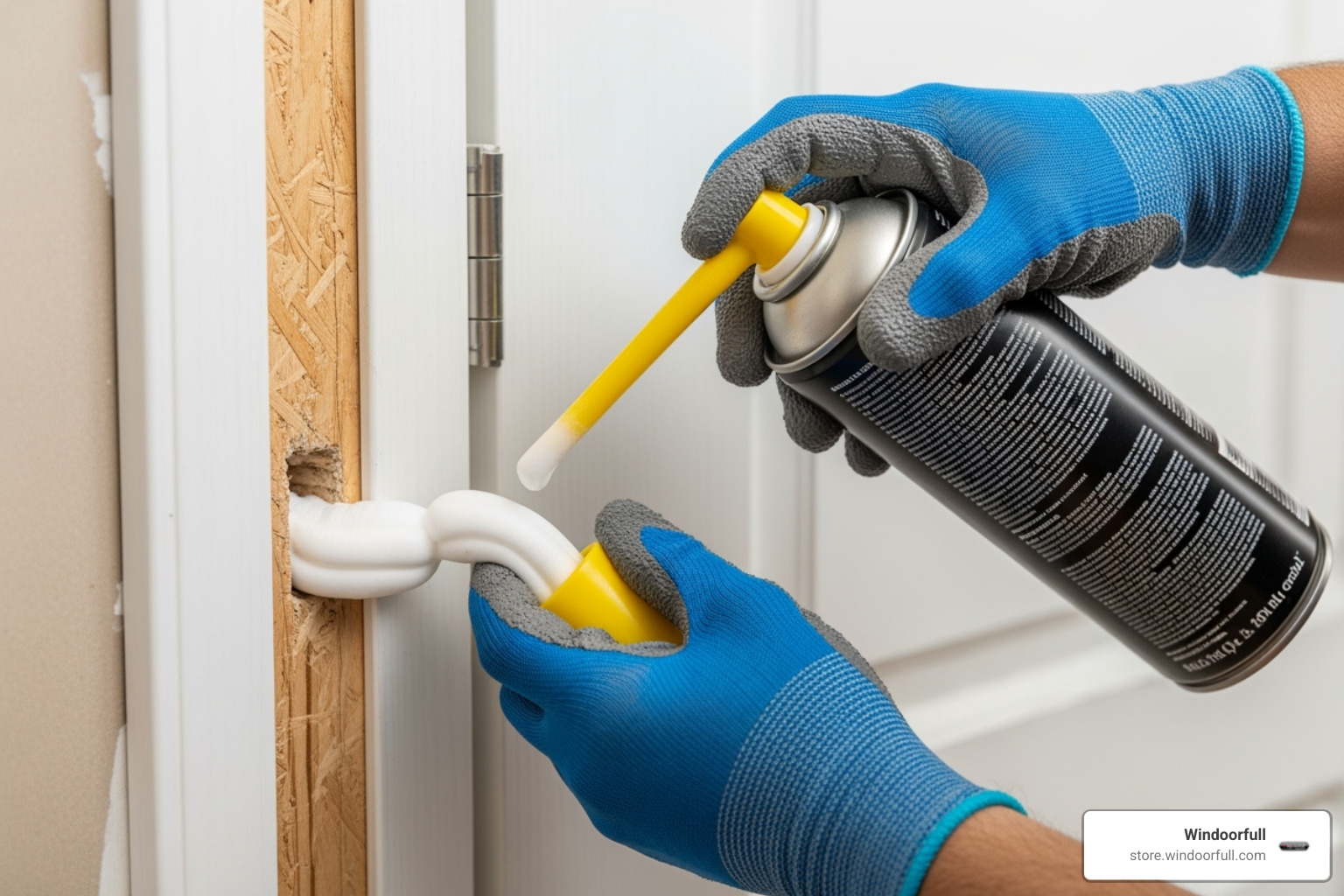
Can You Make an Existing Door More Efficient?
Maybe you're not ready to invest in a brand new energy efficient door right now. That's totally understandable - but you don't have to live with sky-high energy bills while you save up.
There are several smart ways to boost your current door's performance. Start by adding or replacing weatherstripping around the frame. Over time, this material compresses and cracks, creating gaps that let conditioned air escape. New weatherstripping is inexpensive and can make a surprising difference.
Installing a door sweep is another quick win. This simple device seals the gap under your door - often the biggest culprit for drafts. You can caulk air leaks around the frame too, especially where it meets the wall. Look for any cracks or gaps and seal them up with quality caulk.
For doors with glass, consider replacing glass inserts with modern double or triple-pane units that have Low-E coatings. This upgrade can dramatically improve thermal performance without replacing the entire door. You might also add a storm door to create an extra insulating air pocket, especially if your main door is older.
These improvements won't transform an old door into a high-performance system, but they'll definitely help reduce your energy bills and improve comfort while you plan for a full upgrade.
Frequently Asked Questions about Energy-Efficient Doors
When homeowners start exploring energy efficient doors, they naturally have questions about the investment, performance, and practical benefits. Let me share the answers to the most common questions we hear at Windoorfull, based on real experiences and industry data.
How much money can I save with an energy-efficient door?
Your savings with energy efficient doors depend on several factors - your local climate, the quality of your new door compared to your old one, and how well your home is insulated overall. But here's the exciting news: the savings can be quite impressive!
ENERGY STAR data shows that certified windows, doors, and skylights can reduce household energy bills by up to 13% nationwide when replacing single-pane units. Even focusing just on your front door, upgrading to an energy-efficient model typically cuts energy consumption by at least 5%. If you're replacing large, drafty sliding glass doors with modern, efficient ones, you might see energy consumption drop by as much as 55%!
The benefits go beyond your monthly utility bill too. When your door isn't letting heated or cooled air escape, your HVAC system doesn't have to work overtime. This reduces wear and tear on your heating and cooling equipment, potentially extending its lifespan and saving you money on repairs or early replacement. It's like giving your entire home's climate system a well-deserved break.
Are doors with glass energy-efficient?
This question always makes me smile because it touches on a common misconception. Years ago, doors with glass were indeed energy drains - a standard double-pane window could allow about 75% of the sun's heat into your home. But modern glass technology has completely changed the game!
Today's energy efficient doors with glass can absolutely deliver outstanding thermal performance. The secret lies in advanced glass packages that include double or triple-pane construction, Low-E coatings that reflect heat while protecting your furniture from UV damage, and argon or krypton gas fills between the panes for superior insulation.
The frame design matters enormously too. Look for thermal breaks in metal frames - these non-conductive barriers prevent heat from traveling through the frame itself. Warm-edge spacers between glass panes also reduce heat transfer and eliminate those annoying condensation problems.
Our European-style doors are perfect examples of how beautiful, glass-rich designs can deliver exceptional energy efficiency. The multi-chambered uPVC frames combined with high-performance glazing create doors that are both stunning and incredibly efficient.
What's more important: U-Factor or SHGC?
This is one of my favorite questions because the answer really depends on where you call home. Both metrics matter for energy efficient doors with glass, but your climate determines which one deserves top priority.
If you live in a cold climate where winter heating bills make you wince, focus on a low U-Factor. This measures how well your door resists heat loss, so a lower number means better insulation. You want every bit of warmth staying inside where it belongs, not escaping through your door.
In hot climates where air conditioning runs constantly, prioritize a low SHGC (Solar Heat Gain Coefficient). This measures how much solar heat passes through the glass. A lower SHGC means less unwanted heat entering your home, giving your air conditioner a much-needed break during those scorching summer days.
For those in balanced climates with both significant heating and cooling seasons, you'll want to find the sweet spot - moderately low numbers for both U-Factor and SHGC. The easiest way to get this right is checking the ENERGY STAR requirements for your specific climate zone. They've done the math to determine the optimal balance for your area, taking the guesswork out of your decision.
Conclusion
After exploring everything about energy efficient doors, one thing becomes crystal clear: these aren't just ordinary doors – they're sophisticated systems that can transform your home's comfort and your monthly energy bills. We've seen how polyurethane foam cores create incredible insulation, how multi-pane glass with Low-E coatings blocks unwanted heat transfer, and how multi-point locking systems seal out every bit of unwanted air.
The magic happens when all these features work together. Your home stays more comfortable year-round with consistent temperatures from room to room. Those annoying drafts that make you shiver by the front door? Gone. The significant energy savings show up month after month in lower utility bills – some homeowners see reductions of up to 13% in their energy costs. And let's not forget the increased home value that comes with superior curb appeal and modern efficiency features.
Professional installation makes all the difference in open uping these benefits. Even the most advanced door won't perform properly if it's not installed correctly. That's why we always stress the importance of working with experienced professionals who understand the nuances of creating airtight seals and proper thermal barriers.
At Windoorfull, we've made it our mission to bring you authentic European-engineered doors that deliver superior thermal performance through innovative design. Our European-style doors feature multi-chambered uPVC profiles that create natural insulation within the frame itself. Combined with advanced sealing systems and versatile tilt-and-turn functionality, these doors represent the cutting edge of energy efficiency technology.
The investment in quality doors pays dividends in comfort, savings, and peace of mind. Whether you're dealing with harsh winters, sweltering summers, or anything in between, the right door becomes your home's first line of defense against energy waste.
Ready to experience the difference that truly efficient doors can make? Explore our high-performance doors and windows and find how European engineering can transform your home's energy performance while adding lasting beauty to your entrance.
